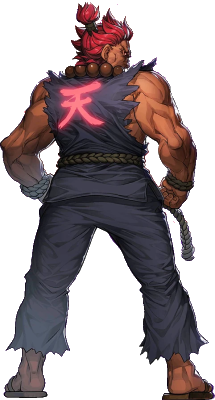
Akuma, known in Japan as Gouki, is a fictional character from the Street Fighter series of fighting games created by Capcom. Akuma made his debut in Super Street Fighter II Turbo as a secret character and an alternative boss to the villain M. Bison. In the storyline of the Street Fighter video games, he is the younger brother of Gouken, Ryu's and Ken's master. After defeating his brother, Akuma gains interest in several fighters, most notably Ryu as he senses that the protagonist has a similar power to him known as the Satsui no Hadou. In some games, he also has an alternate version named Shin Akuma or Shin Gouki in Japanese and Oni Akuma in Super Street Fighter IV: Arcade Edition.
SNK vs. Capcom, or alternately Capcom vs. SNK, is a series of crossover video games by either Capcom or SNK featuring characters that appear in games created by either company. Most of these are fighting games, and take on a similar format to Capcom's own Marvel vs. Capcom series, in which the players create teams of fighters and have them fight each other. Games in this series either contain SNK vs. Capcom or Capcom vs. SNK in their titles, with the first company named denoting the company behind the game's development.

Marvel vs. Capcom is a series of crossover fighting games developed and published by Capcom, featuring characters from their own video game franchises and comic book series published by Marvel Comics. The series originated as coin-operated arcade games, though later releases would be specifically developed for home consoles, handhelds, and personal computers.

X-Men vs. Street Fighter is a crossover fighting video game developed and published by Capcom. It is Capcom's third fighting game to feature Marvel Comics characters, following X-Men: Children of the Atom and Marvel Super Heroes, and is the first installment in the Marvel vs. Capcom series. As the title suggests, the game includes characters from Marvel's X-Men franchise and the cast from Capcom's Street Fighter series. Originally released as a coin-operated arcade game in 1996, it was ported to the Sega Saturn in 1997 and the PlayStation in 1998.
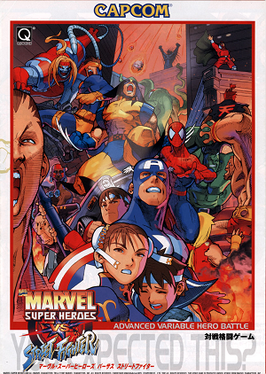
Marvel Super Heroes vs. Street Fighter is a crossover fighting video game developed and published by Capcom. It is the sequel to X-Men vs. Street Fighter and the second installment in the Marvel vs. Capcom series. The game was first released as an arcade game in 1997. It then received ports to the Sega Saturn in 1998 and the PlayStation in 1999.

Street Fighter Alpha 3, released as Street Fighter Zero 3 in Japan, Asia, South America, and Oceania, is a 2D fighting game originally released by Capcom for the arcade in 1998. It is the third and final installment in the Street Fighter Alpha sub-series, which serves as a sequel to Street Fighter Alpha 2, and ran on the same CP System II hardware as previous Alpha games. The game was produced after the Street Fighter III sub-series has started, being released after 2nd Impact, but before 3rd Strike. Alpha 3 further expanded the playable fighter roster from Street Fighter Alpha 2 and added new features such as selectable fighting styles called "isms".

X-Men: Children of the Atom is an arcade game that was produced by Capcom and released on the CP System II arcade hardware in 1994 in Japan and in 1995 in North America and Europe.

Marvel Super Heroes is a fighting video game developed by Capcom. Originally released in the arcade in 1995 on the CPS-2 arcade system, it was ported to the Sega Saturn and PlayStation in late 1997. The game, alongside Marvel vs. Capcom: Clash of Super Heroes, was also included in the Marvel vs. Capcom Origins collection, released digitally for the PlayStation 3 and Xbox 360 in September 2012.
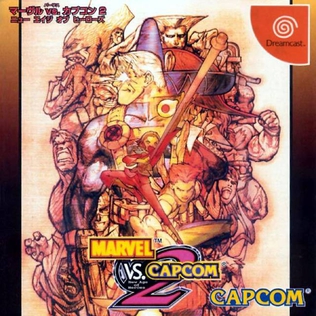
Marvel vs. Capcom 2: New Age of Heroes is a crossover fighting game developed and published by Capcom. It is the fourth installment in the Marvel vs. Capcom series, which features characters from both Capcom's video game franchises and comic book series published by Marvel Comics. Originally released in Japanese arcades in 2000, the game received ports to the Dreamcast, PlayStation 2, PlayStation 3, Xbox, Xbox 360, and iOS devices over the span of twelve years.

Street Fighter III: 2nd Impact - Giant Attack is a competitive fighting game produced by Capcom that was released as a coin-operated arcade game in 1997. It is an update of Street Fighter III: New Generation. Like its predecessor, it runs on the CP System III hardware. 2nd Impact introduced new gameplay mechanics, new characters, and new special moves. The game also brings back bonus rounds, not seen in the series since Super Street Fighter II. It is also the only CPS3 title to have a widescreen feature.

Street Fighter III: 3rd Strike - Fight for the Future is a 2D fighting game developed and published by Capcom, originally released in 1999 for the arcades and in 2000 for the Dreamcast. In 2004 it was released on the PlayStation 2 and Xbox. A downloadable online version titled Street Fighter III: 3rd Strike Online Edition was released on PlayStation Network and Xbox Live Arcade in 2011.

Capcom vs. SNK: Millennium Fight 2000, also known as simply Capcom vs. SNK in international releases, is a 2000 head-to-head fighting game produced by Capcom originally released as a coin-operated arcade game for Sega's NAOMI hardware and later ported to the Dreamcast. It is the second game in the SNK vs. Capcom series and the first game in the series to be released for the arcade.

JoJo's Bizarre Adventure is a fighting video game developed by Capcom based on Hirohiko Araki's manga of the same title. The game was developed by the same team who was responsible for the Street Fighter III series.
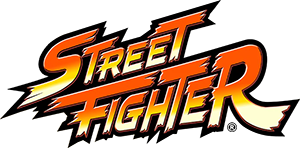
Street Fighter is a Japanese media franchise centered on a series of fighting games developed and published by Capcom. The first game in the series was released in 1987, followed by six other main series games, various spin-offs and crossovers, and numerous appearances in other media. Its best-selling 1991 release Street Fighter II established many of the conventions of the one-on-one fighting genre.

Marvel vs. Capcom 3: Fate of Two Worlds is a crossover fighting video game developed by Capcom in collaboration with Eighting. The game features characters from both Capcom's video game franchises and comic book series published by Marvel Comics. It was released for the PlayStation 3 and Xbox 360 consoles in February 2011. It is the sequel to 2000's Marvel vs. Capcom 2: New Age of Heroes, the fifth installment of the Marvel vs. Capcom franchise, and the first to use three-dimensional character models instead of two-dimensional sprites.

Ultimate Marvel vs. Capcom 3 is a crossover fighting game developed by Capcom in collaboration with Eighting. It is an updated version of Marvel vs. Capcom 3: Fate of Two Worlds. The game features characters from both Capcom's video game franchises and comic book series published by Marvel Comics. The game was released in November 2011 for the PlayStation 3 and Xbox 360, and was featured as a launch title for the PlayStation Vita in 2012. The game was later ported to PlayStation 4 in December 2016, and Windows and Xbox One in March 2017.

Marvel vs. Capcom Origins is a crossover fighting video game developed by Iron Galaxy Studios and published by Capcom. It is a compilation of Marvel Super Heroes (1995) and Marvel vs. Capcom: Clash of Super Heroes (1998). The dual pack was released through the PlayStation Network and Xbox Live Arcade in September and October 2012, respectively.
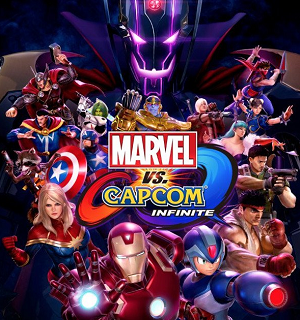
Marvel vs. Capcom: Infinite is a fighting video game developed and published by Capcom. It is the sixth main entry in the Marvel vs. Capcom series of crossover games. Like previous installments, players control characters from both the Marvel Comics and Capcom universes to compete in tag team battles. Infinite features two-on-two fights, as opposed to the three-on-three format used in its preceding titles. The series' character-assist moves have been removed; instead, the game incorporates a tag-based combo system, which allows players to instantly switch between their two characters to form continuous combos. It also introduces a new gameplay mechanic in the form of the Infinity Stones, which temporarily bestow players with unique abilities and stat boosts depending on the type of stone selected.

















